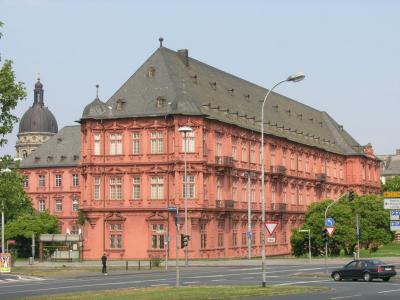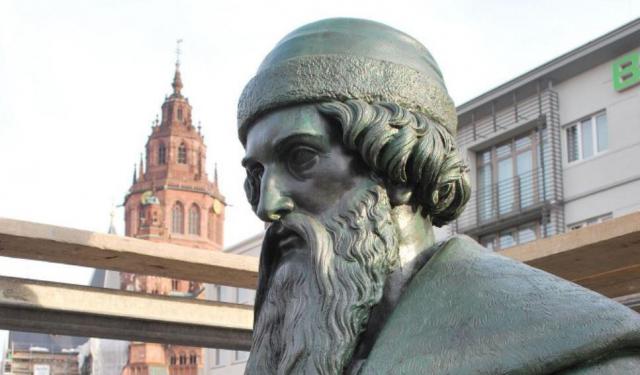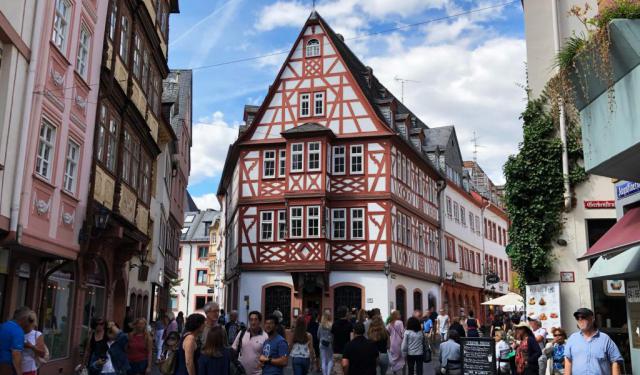
Kurfürstliches Schloss (Electoral Palace), Mainz
The Electoral Palace in Mainz (German: Kurfürstliches Schloss zu Mainz) is the former city Residenz of the Prince-elector and Archbishop of Mainz. It is one of the important Renaissance buildings in Germany.
The building of a new palace commenced in 1627 on the behest of Archbishop Georg Friedrich von Greiffenklau. The Rhine wing of the new palace could not be finished until 1678, construction being delayed by the Thirty Years War and the War of the Grand Alliance. The original plan is not known, but it was probably a four-wing construction, comparable to the 1604 repairs to Schloss Johannisberg. It can be assumed Martinsburg remained standing only because of the delays.
The north wing was begun in 1687, ready by 1752, and furnished in succeeding years. Work on the wing extending away from the river was begun during the reigns of Johann Friedrich Karl von Ostein (1743–1763) and Friedrich Karl Josef von Erthal (1774–1802). Erthal was the last Prince-Elector of the old electorate. His successor Karl Theodor von Dalberg was both Archbishop-Elector of Mainz and Arch-Chancellor of the remaining Empire on the right bank of the Rhine. Due to the resolutions of the Reichsdeputationshauptschluss his seat was moved to Regensburg, which became the new seat of the archbishopric.
Delays were due not only to the War of the Grand Alliance, but also to the extensive building activity of the nobility: for example, the Lustschloss Favorite begun in 1700 by Lothar Franz von Schönborn absorbed large amounts of resources. That summer residence was destroyed during the Siege of Mainz by coalition shelling in 1793.
On 23 October 1792, the Jacobin Club, a political group during the French Revolution, was established on what nowadays is German soil. This was the earliest democratic movement in Germany. The last Elector of Mainz was expelled in the same year, and the palace was neglected until 1827, when it was restored by the Grand Duchy of Hesse-Darmstadt and the City of Mainz.
During World War II, the building was heavily damaged, especially in the air raid of 27 February 1945, which destroyed most of the city. Of the palace, only the exterior walls remained. It was rebuilt during 1948 and 1949, reopened on 31 December 1949, and was the main venue in Mainz for Karneval activities until the Rheingoldhalle opened in 1968.
Stylistically, the Electoral Palace is one of the last examples of German Renaissance architecture. The northern wing, built later, conforms to this style. The exterior, with turrets at every corner, is richly decorated, particularly around the windows. The roofs have been restored with exactness. The most spectacular interiors included the Grand Staircase by the leading Baroque architect Balthasar Neumann, which was removed during the French occupation.
Today the east wing houses the Römisch-Germanisches Zentralmuseum. An assortment of replicas and valuable original items presents a comprehensive picture of the cultural life of prehistoric times, of the Roman Empire, and of the early Middle Ages. The north wing contains the famous function hall from which the annual Mainz carnival TV show Mainz bleibt Mainz, wie es singt und lacht is broadcast. The Electoral Palace is now one of eight venues managed by Congress Centrum Mainz. There are seven halls and many smaller rooms, enabling events to be staged for up to 1,700 persons.
The building of a new palace commenced in 1627 on the behest of Archbishop Georg Friedrich von Greiffenklau. The Rhine wing of the new palace could not be finished until 1678, construction being delayed by the Thirty Years War and the War of the Grand Alliance. The original plan is not known, but it was probably a four-wing construction, comparable to the 1604 repairs to Schloss Johannisberg. It can be assumed Martinsburg remained standing only because of the delays.
The north wing was begun in 1687, ready by 1752, and furnished in succeeding years. Work on the wing extending away from the river was begun during the reigns of Johann Friedrich Karl von Ostein (1743–1763) and Friedrich Karl Josef von Erthal (1774–1802). Erthal was the last Prince-Elector of the old electorate. His successor Karl Theodor von Dalberg was both Archbishop-Elector of Mainz and Arch-Chancellor of the remaining Empire on the right bank of the Rhine. Due to the resolutions of the Reichsdeputationshauptschluss his seat was moved to Regensburg, which became the new seat of the archbishopric.
Delays were due not only to the War of the Grand Alliance, but also to the extensive building activity of the nobility: for example, the Lustschloss Favorite begun in 1700 by Lothar Franz von Schönborn absorbed large amounts of resources. That summer residence was destroyed during the Siege of Mainz by coalition shelling in 1793.
On 23 October 1792, the Jacobin Club, a political group during the French Revolution, was established on what nowadays is German soil. This was the earliest democratic movement in Germany. The last Elector of Mainz was expelled in the same year, and the palace was neglected until 1827, when it was restored by the Grand Duchy of Hesse-Darmstadt and the City of Mainz.
During World War II, the building was heavily damaged, especially in the air raid of 27 February 1945, which destroyed most of the city. Of the palace, only the exterior walls remained. It was rebuilt during 1948 and 1949, reopened on 31 December 1949, and was the main venue in Mainz for Karneval activities until the Rheingoldhalle opened in 1968.
Stylistically, the Electoral Palace is one of the last examples of German Renaissance architecture. The northern wing, built later, conforms to this style. The exterior, with turrets at every corner, is richly decorated, particularly around the windows. The roofs have been restored with exactness. The most spectacular interiors included the Grand Staircase by the leading Baroque architect Balthasar Neumann, which was removed during the French occupation.
Today the east wing houses the Römisch-Germanisches Zentralmuseum. An assortment of replicas and valuable original items presents a comprehensive picture of the cultural life of prehistoric times, of the Roman Empire, and of the early Middle Ages. The north wing contains the famous function hall from which the annual Mainz carnival TV show Mainz bleibt Mainz, wie es singt und lacht is broadcast. The Electoral Palace is now one of eight venues managed by Congress Centrum Mainz. There are seven halls and many smaller rooms, enabling events to be staged for up to 1,700 persons.
Sight description based on Wikipedia.
Want to visit this sight? Check out these Self-Guided Walking Tours in Mainz. Alternatively, you can download the mobile app "GPSmyCity: Walks in 1K+ Cities" from Apple App Store or Google Play Store. The app turns your mobile device to a personal tour guide and it works offline, so no data plan is needed when traveling abroad.
Kurfürstliches Schloss (Electoral Palace) on Map
Sight Name: Kurfürstliches Schloss (Electoral Palace)
Sight Location: Mainz, Germany (See walking tours in Mainz)
Sight Type: Attraction/Landmark
Sight Location: Mainz, Germany (See walking tours in Mainz)
Sight Type: Attraction/Landmark
Walking Tours in Mainz, Germany
Create Your Own Walk in Mainz
Creating your own self-guided walk in Mainz is easy and fun. Choose the city attractions that you want to see and a walk route map will be created just for you. You can even set your hotel as the start point of the walk.
In the Footsteps of Gutenberg
The capital of Rhineland-Palatinate, Mainz has made a name throughout the world as Gutenberg's city, the birthplace of Johannes Gutenberg and his great invention, the first movable metal-type printing press. It is precisely for this important heritage that Mainz has retained its importance as a hub for some of Germany's oldest publishing houses.
Following in the footsteps of Gutenberg... view more
Tour Duration: 1 Hour(s)
Travel Distance: 1.2 Km or 0.7 Miles
Following in the footsteps of Gutenberg... view more
Tour Duration: 1 Hour(s)
Travel Distance: 1.2 Km or 0.7 Miles
Mainz Introduction Walking Tour
Mainz is the Rhineland-Palatinate state capital and its largest city. It is located on the Rhine river, where the Main river joins the Rhine. Mainz has remained a prosperous city and is an important container port hub.
Mainz was founded as a Roman military fortress in the 1st century BC. The Roman stronghold was called Mogontiacum. Visitors can see several Roman shipwrecks and learn more about... view more
Tour Duration: 2 Hour(s)
Travel Distance: 3.3 Km or 2.1 Miles
Mainz was founded as a Roman military fortress in the 1st century BC. The Roman stronghold was called Mogontiacum. Visitors can see several Roman shipwrecks and learn more about... view more
Tour Duration: 2 Hour(s)
Travel Distance: 3.3 Km or 2.1 Miles


